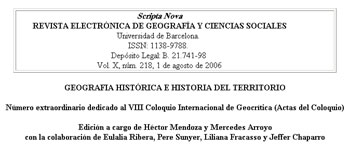Difussion and Diocesans Territories in Brazil: 1551 – 1930
Keywords:
territory, difusion, periods, diocese, popular catholicismAbstract
Between the beggining of the Portuguese colonization and 1930, the formation of Catholic diocesans territories in Brazil was a result of a complex process of spatial diffusion. In this process has taken part the country’s dimension, the occupation process, and the needs and possibilities of the Catholical Church. Two periods can be identified, 1551–1854 and 1890–1930. The first one is represented by the submission of the Catholical Church to the Portuguese Crown and its superficial appropriation and control of its 12 territories diocesans spread around 8,5 millions of Km². The second period is associated with the separation between Church and State and the creation of 68 news dioceses spread around the country, although they are placed very close at South-east and North-east. The strategies of Catholical Church change according different logics, although, the appropriation and control is still superficial. Its results was the development of a popular catholicism, wich is dominanting in Brazil.Downloads
Published
2007-05-03
Issue
Section
Articles
License
Los autores que publican en esta revista están de acuerdo con los siguientes términos:
- Los autores conservan los derechos de autoría y otorgan a la revista el derecho de primera publicación, cin la obra disponible simultáneamente bajo una Licéncia de Atribución Compartir igual de Creative Commons que permite compartir la obra con terceros, siempre que estos reconozcan la autoría y la publicación inicial en esta revista.
- Los autores son libres de realizar acuerdos contractuales adicionales independientes para la distribución no exclusiva de la versió de la obra publicada en la revista (com por ejemplo la publicación en un repositorio institucional o en un libro), siempre que se reconozca la publicación inicial en esta revista.





